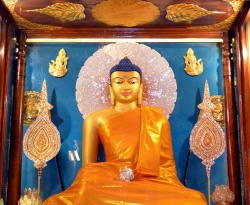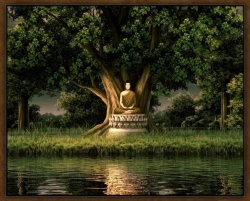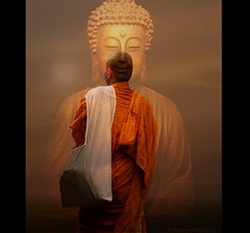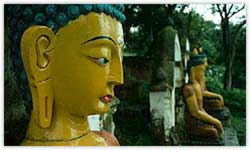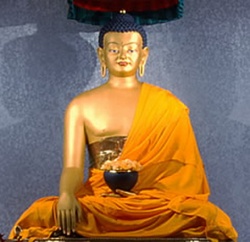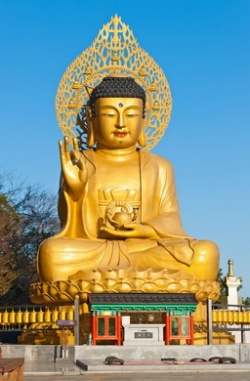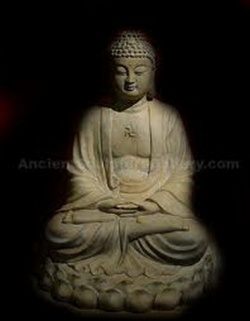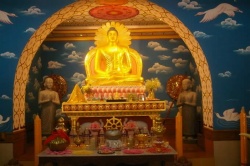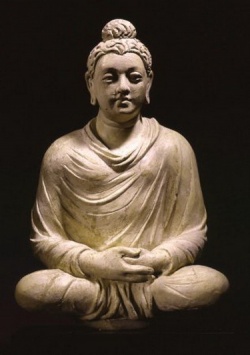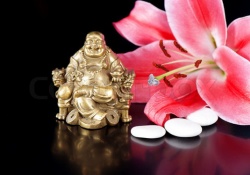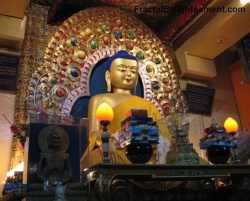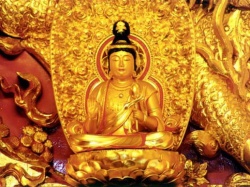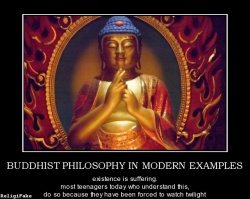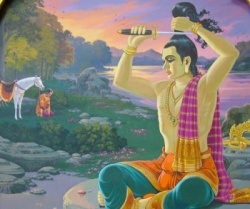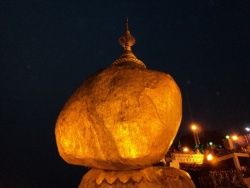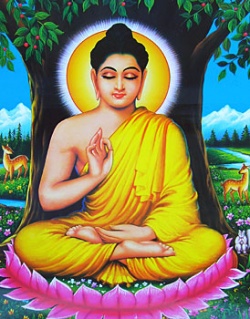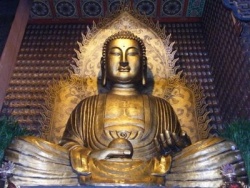Relics of the Buddha
In 1561, an interesting ceremony took place in the Portuguese enclave of Gõa, in Southwestern India. During a military operation in Sri Lanka, Portuguese troops had captured what "local idolaters" (i.e., Buddhists) claimed was the tooth of the Buddha, and had delivered it as a prize to their viceroy, Don Constantino da Bragança. The viceroy had hoped to hold it for ransom, but now the archbishop of Gõa, Don Gaspar, was insisting that it be destroyed. On a porch overlooking the river, in the presence of a great crowd of Christians and "pagans," he called for the tooth and "placed it in a mortar, and with his own hand reduced it to powder, and cast the pieces into a brazier which stood ready for the purpose; after which the ashes and the charcoal together were cast into the river, in sight of all those who were crowding the verandahs and windows which looked upon the water" (Tennent 1859, 2:215. See also chapter 7 in this book).
As benighted as such an action may seem to us today, it can at least be said that the Portuguese archbishop appreciated the nature of relics. Conscious of the power of holy objects from his own tradition, he felt that the tooth had to be utterly and permanently eradicated. In his mind, this was not just a piece of bone that he was destroying but a "relic of the devil" (reliquia do demonio) something alive that had to be killed (Tennent 1859, 2:214; text in De Couto 1783, 17:429).1
Rather different were the attitudes of some of Don Gaspar's Protestant contemporaries in Europe. John Calvin, to my knowledge, never said anything about Buddhist relics, but in 1543 he wrote a whole treatise on Roman Catholic ones (Calvin 1970). And although he too, given the chance, would probably have crushed the Buddha's tooth to bits, he would have done so for different reasons. For him, relics embodied no sacred or even demonic presence, and it was wrong and exploitative to pretend that they did. Relics were nothing but material things, as he pointed out when he got rid of what had been two of Geneva's prized relics--the arm of Saint Anthony and the brain of Saint Peter; the one, he proclaimed, was but the bone of a stag, and the other a piece of pumice (Calvin 1970: 53).2
This is not the place to examine the varying influences of Roman Catholicism and Protestantism on the comparative study of material objects of devotion. Suffice it to say that Western scholarship on relics is heir to two rather different sets of prejudices, the one affirming the ongoing presence and power of the supernatural in objects, the other maintaining its ontological absence and seeing such objects as no more than material symbols or signifiers of a "divine" being or power whose locus is elsewhere or who died long ago.
During the nineteenth and early twentieth century, at least in certain circles, the second, or "Protestant," perspective came to predominate in the study of Buddhism. Championing the claim that the Buddha, after his final nirvana, was totally removed from any relationship to this world, scholars tended to see Buddhist objects of devotion such as images and relics not as embodying the impossible presence of a deceased Master, but as mere mnemonic devices for recalling his teaching and his example. The Buddha was to be found primarily in his doctrine; to think of him as present elsewhere, in statues or relics, for instance, was an aberration to be condemned--as one missionary-scholar put it--as "mere material worship," akin to the Roman Catholic cults of "the [seamless] Garment of our Lord," of "the skulls of the Three Wise Men" in Cologne, and of the "exceedingly numerous" portions of the True Cross, all of which were "examples of a dark age" (Wylie [1897] 1966: 79-80).3
"True Buddhism," understood as the original teachings of the Buddha, was thought to have nothing to do with such things as relics. Thus, the American Monist Paul Carus, whose book, The Gospel of Buddha, achieved considerable popularity around the turn of the century, turned down the offer of a Buddha relic from a Sri Lankan monk, telling him, "The worship of relics, be they bones, hair, teeth, or any other substance of the body of a saint, is a mistake. . . The soul of Buddha is not in his bones, but in his words, and I regard relic-worship as an incomplete development in which devotees have not as yet attained to full philosophical clearness" (Carus 1897: 123).4 Along these lines, it was often assumed that those who had reached "full philosophical clearness" were the cultured monastic elite, while those who had not and worshiped relics and images were the laity. The existence of relics in the Buddhist tradition, when it was recognized at all, was thus seen as a concession to the superstitious and devotional needs of the lay populace. Espoused by prominent scholars such as Hermann Oldenberg (1928: 377), this "two-tiered" view lingered well into the twentieth century and may, indeed, still be found.5
In more recent times, however, a pendulum swing away from such opinions has taken place in the study of Buddhism. Already in 1973, David Snellgrove declared that, although "there were certainly pure philosophical doctrines propounded during the early history of Buddhism, just as there have been ever since, . . . there is no such thing as pure Buddhism per se except perhaps the cult of Sakyamuni as a supramundane being and the cult of the relic stupa (1973: 411). In more recent times, inspired by the emergence of sophisticated studies of Christian relics (e.g., Brown 1981, Geary 1978), religious images (Freedberg 1989), notions of the body (Bynum 1995, Dissanayake 1993) and death practices (Ariès 1982, Danforth 1982, Bloch and Parry 1982), buddhologists have developed a new seriousness about material culture in general and relics in particular. Thus today, as Robert Sharf (1999: 78) has pointed out,
"[I]t is no longer acceptable to dismiss casually the worship of relics and images as aberrant or un-Buddhist, as a sop to the plebeian needs of the unlettered masses. Scholars now appreciate that, with few exceptions, the clerical elite found nothing objectionable in the worship of relics, but enthusiastically engaged in and promoted such activities themselves. There is thus little reason to believe that the display of relics contravenes either the letter or the spirit of Buddhist teachings."6
In questioning Protestant presuppositions in the field, buddhologists, in fact, have developed new perspectives of the tradition they study.7 As Sharf (1999: 79), again, has commented, "Buddhism may no longer resemble European humanism, mysticism (the 'perennial philosophy'), or enlightened rationalism, but it has come to bear an uncanny resemblance to medieval [[Wikipedia:Christianity|Christianity]] . . . [with] its saints, relics, and miraculous images." In this process, certain views that attribute power and life and "presence" to the relics have reemerged. For instance, Gregory Schopen, who has eloquently critiqued Protestant prejudices in the study of Buddhism, has also explored the many ways in which the Buddha was thought to be "alive" in his relics: he / they had rights as a legal "person," or could own property; and destroying a stupa containing relics was viewed as a capital offense, in other words, as the murder of a living person (Schopen 1997: 125ff. and 258ff., 1995, and 1996a). Alternatively, relics were seen as "saturated / invigorated / enlivened by morality, concentration, wisdom, emancipation, knowledge and vision," that is, "exactly the same spiritual forces and faculties that characterize, . . . constitute and animate the living Buddha" (Schopen 1997: 154). Elsewhere, Schopen declares that "there is no distinction between a living Buddha and a collection of relics--both make the sacred person equally present as an object of worship, and the presence of either makes available the same opportunity to make merit" (1997: 132).
As a number of scholars have pointed out, this comes very close to attributing to Buddhists a kind of Lévy-Bruhlian "prelogical mentality" that senses a "mystical participation" (Lévy-Bruhl 1926: 76-7) between the Buddha and his relics,8 or a Robertson Smith-like view of objects being "instinct with divine life" or "embodiments of the presence of the deity" (Smith 1972: 173, 204).9 I shall have more to say about Schopen's views of relics later. For now, suffice it to point out that, in the final analysis, he appears to shy away from an ontological equation of the Buddha and his relics and to assert rather their ritual and functional equivalence. The relics are alive, own property, perform miracles, inspire devotees, are filled with various buddha qualities, in exactly the same way that the Buddha is. This does not mean that they are the Buddha, that they make him present. Rather they are themselves present in the same way that he is, they can act like him, they are a substitute for him in his absence.
In between the poles of absence and presence, there is clearly a lot of room for positions that seek, in various ways, to combine the two views. Indeed, as more and more scholars have payed attention to Buddhist relics, a plethora of positions attempting to pin down this dialectical relationship have emerged. These cannot all be spelled out here. To put it succinctly, we now have open to us the possibility of viewing Buddhist relics as "indexical icons" (Tambiah 1984: 5, and 204, inspired by C. S. Peirce and Arthur Burks), "sedimentations of charisma" (Tambiah 1984: 335ff., developing Max Weber), products of the Buddhist "habitus" (Kinnard 1999: 9-11, 157-58, inspired by Pierre Bourdieu), "zero signifiers" (Ohnuki-Tierney 1994, inspired by Roman Jakobson and John Lotz, and Jacques Derrida), "chronotopes" (Eckel 1992: 62, inspired by Mikhail Bakhtin), "heterotopias" (Eckel 1992: 63, inspired by Michel Foucault), and places "where an absence is present" (Eckel 1992: 65, inspired by Nagarjuna and Bhavaviveka). They can also be seen as the manifest presence of an essence that acts as a "visible representation of the immortal nirvana state," and that helps reconcile a contradiction between a "cognitive" understanding that the Buddha is dead, and a "psychological" or "affective" sense that he is living (Obeyesekere 1966: 8);10 as "memory sites" that are "the ultimate embodiment of a commemorative consciousness" (Hallisey 1996: 7, inspired by Pierre Nora); as manifestations of the postmortem force of a buddha's resolutions (Trainor 1997: 136-88, inspired by Buddhaghosa); as "metamorphoses of the double" (Faure 1991: 132-47, inspired by Robert Hertz); as embodiments of "the sense of an ending" (Collins 1992: 233, inspired by Frank Kermode); as that "final and insensible scream that is the 'supreme affirmation of life'" (Sharf 1999: 90, inspired by Georges Bataille); as "instruments of magical power [and] kernels of pure imaginaire" (Faure 1999: 15, after Jacques LeGoff); as instances of "euphemization" (Ruppert 2000: 96, inspired by Pierre Bourdieu); as "hierophanies" (Schober 2001, following Mircea Eliade); as particular forms of buddha-emanation bodies (Bentor 1996, based on Tibetan nirmanakaya [sprulsku] doctrine); as "blazing absences" (Germano 1994, based on Tibetan Nying ma sources); and probably in many other ways.
RELICS AND THE BIOGRAPHICAL PROCESS
In this book, I would like to approach this whole question on a slightly different tack. I propose to view relics not as the embodiments of a transcendent or imminent or otherwise absent Buddha, nor just as functionally equivalent to the departed Master, but as expressions and extensions of the Buddha's biographical process. The same point has been made by others, especially with regard to buddha images. Juliane Schober (1997: 260-68), for instance, has shown how the relic-like Mahamuni image of the Buddha in Mandalay was thought of as a continuator of the life story of the Buddha, to the extent that it was even deemed to have to suffer some of the unworked-out negative karma dating from the Buddha's previous lives. More generally, Donald Swearer (forthcoming) has demonstrated how image consecration ceremonies, at least in Northern Thailand, involve the ritual narrative infusion into the image of the whole life of the Buddha, especially of the event of his enlightenment. As he puts it elsewhere, "[T]he sacred biography takes a concrete, visual form in the very image of the Tathagata" (1995: 268).
Much the same thing may be found in the practice of enshrining relics in the midst of architectural or artistic reminders of the Buddha's life story. I will examine a classic instance of this, in chapter 6, in the case of the relic chamber of King Dutthagamani's "Great Stupa" in Sri Lanka (first century B.C.E.). For now, suffice it to cite an example from Southeast Asia. In 1912, an earthquake in Northern Burma crumbled the corners of the Hlèdauk Pagoda, laying bare two of its relic chambers. Inside were found not only a vessel containing relics of the Buddha, but "many small figures in bronze representing the most important scenes in the life of [the] Buddha" (Duroiselle 1911-12: 149). These included representations of the first jataka, the story of Sumedha prostrating himself at the feet of the past buddha Dipamkara; images of all the other twenty-eight previous buddhas venerated by the Buddha in his past lives; figurines depicting the Buddha's mother, Mahamaya, giving birth to him; the seven steps he took immediately after he was born; the signs of the old man, sick man, dead man, and ascetic that prompted him to go forth on his "great departure"; scenes of him cutting off his hair with his sword and of Indra receiving that hair relic in heaven; statuettes showing his enlightenment and the events of each of the seven weeks following it; the first sermon he preached to his first five disciples; and various events from his teaching career, ending with the scene of his death and parinirvana (Duroiselle 1911-12: 150-51).11 Such "bioramas," as they may be called, are not uncommon,12 and they testify to the importance of the life story of the Buddha in defining the nature of a relic.
It should be remembered that in Buddhism, it is biography that makes a buddha and not the Buddha who makes his biography. In other words, all buddhas, even in the Theravada tradition, follow a biographical blueprint that defines them and makes them who they are (see Strong 2001: 10-14). At the most fundamental level, this biographical blueprint is the story of someone who comes and goes in the same way that other buddhas have come and gone. Another way of putting this is that it is the story of someone who becomes present as a buddha--who works toward buddhahood through his past lives and his quest for enlightenment, and manifests that buddhahood in his teaching--and who then becomes absent as a buddha, through his death and his parinirvana. The great lesson of Buddhism is not that of impermanence, if, by impermanence is simply meant "nothing lasts forever." It is rather that of process--that things, beings, buddhas come into existence due to certain causes and go out of existence due to certain causes. Indeed, the one verse that best summarizes the whole teaching of the Buddha is the often-repeated and copied formula: "Ye dharma hetuprabhavas tesam hetum Tathagata uvaca / tesam ca yo nirodha evam vadi mahasramanah " ("The Tathagata has explained the cause of those elements of reality (dharmas) that arise from a cause, and he, the Mahasramana [the "Great Recluse"], has also spoken of their cessation").
It is worth considering the implications of this for our study of relics. It is my contention that the Buddha himself, in his life story, exhibits the truth of this formula, in that his biography tells the causes of his final life and buddhahood as well as their cessation. His relics, in so far as they are expressions of the Buddha's biography, are thus also expressions of this process. In this regard, Buddhist relics (unlike Christian relics) do not make manifest some transcendent or immanent reality, but retell a tale; they sum up a biographical narrative; they embody the whole of the Buddha's coming and going, his life-and-death story; they reiterate both his provenance and his impermanence.13 This is true, even when their immediate reference is only to one portion of that biography14 for, as Steven Collins (1992: 241) has pointed out, "when an enshrined relic is venerated, the whole story is implicitly present." Though they are material objects, relics can thus help bring to mind and invite reflection on a whole narrative that is upheld and recognized by the community.
At the same time, however, relics are also extensions of the Buddha's biography. It is perhaps possible to think of this as an assertion of the ongoing "presence" of the Buddha, but it is preferable to think of it as the further development of a powerful narrative. Simply put, though the life of the Buddha stops with his parinirvana, his biography goes on. (Similarly, though his life starts with his birth in Lumbini, his biography begins much earlier than that with his previous lives). The Buddha's relics, as we shall see, do not just recall events from his life, but have adventures of their own. They travel to distant countries, to heavens and naga worlds. They help legitimate empires here on earth and they further spread the dharma to places that the living Buddha never visited. Sometimes these adventures have been foretold, predestined, by the Buddha himself; at other times they have not. Sometimes they are aided and abetted by the actions of humans; at other times, they take on a life of their own. Either way, the relics continue to do things the Buddha did, to fill the roles the Buddha filled; but they also do new things that the Buddha never did. They write new chapters in the Buddha's life story. Even so, the ultimate end of the story is not new, for like the Buddha's body before them, and like the Buddha's dharma after him, the relics are subject to dissolution. Indeed, as we shall see in chapter 8, the true end of the Buddha's biography comes only with the end of the relics, at that time still in the future in which all the relics will assemble again and undergo a parinirvana (final extinction) of their own.
TYPES OF BUDDHA RELICS
I have, so far, been talking about Buddhist relics as though they were all a single sort of thing, but obviously that is not the case. In fact, various classification schemes dividing relics into different categories were developed by the Buddhist tradition. If we look again at the account with which we began the preface to this book, Daorong's description of what he found in Nagarahara, it is easy to see that there were actual remains of parts of the Buddha's body (bones, teeth, and hair), objects that once belonged to the Buddha (the staff), things associated with the Buddha's teaching (the sinking stupa and the inscription), and then a host of more ambiguous traces of the Buddha's former presence (his shadow image, his footprints, and the rock where he washed his robe). The first three of these items correspond pretty much to important Indian relic classification schemes that distinguish (1) body relics, (2) contact relics, that is, objects that the Buddha owned or used or with which he was closely associated, such as bowls, robes, bodhi trees (or in this case, his staff); and (3) dharma relics, by which was meant either whole sutras, or a dharma verse (such as the "ye dharma . . ." formula given earlier), or a dharani, or anything somehow recording the Buddha's teaching (see Bentor 1994: 16 and the sources quoted there).
Bones and Books
The inclusion of the Buddha's dharma--more literally of actual texts--in the category of relics is significant (see Wallis 2001). As is well known, when the Buddha, on his deathbed, was asked by his disciple Ananda who should replace him after he was gone, his answer was his teachings, his dharma.15 There was a sense, then, that the dharma could act as a substitute for the departed master, a claim that was taken quite literally in certain circles. "One who sees the dharma sees the Buddha" (Mil., 71 = Eng. trans., Davids 1890-94, 1:110) went the assertion, and this was true regardless of whether the Buddha was alive or dead.16 Similarly, other texts were to declare that "when the relics are seen, the Buddha is seen,"17 a parallelism that should not go unnoticed. It comes as no surprise, then, to find that some later texts actually rewrote the Buddha's deathbed words to have him say that, after his death, the dharma, vinaya and his bodily relics will be his disciples' teacher (see Jinal., 49 = Eng. trans., Gray 1894: 110).18
Not all Buddhists, however, were in agreement about the validity of this parallelism. In one of the Perfection of Wisdom sutras, for instance, when it is asked which is better, the whole of "Jambudvipa filled up to the top with [[[Buddha]]]-relics" or "a single written copy of this perfection of wisdom [[[sutra]]]?" the answer is unequivocal: the perfection of wisdom scripture is preferable for the relics are subordinate to it; they are worshiped only because "they are pervaded by the perfection of wisdom" (Conze 1973: 116; text in Asta, 48). And later, in the same text, the bodhisattva Dharmodgata proclaims that the Buddha "cannot be seen" from his physical body, but only from his dharma (Conze 1973: 291).19 Nevertheless, the fact remains that, in the context of the tradition broadly conceived, both dharma relics and body relics could be used in similar ways as stand-ins for the Buddha. For instance, stupas and images and other objects that served as reminders of the Buddha were often consecrated or "enlivened" by the insertion within them of a body relic (e.g., a piece of bone), or of a textual dharma relic (e.g., a written verse from the Buddha's teaching), or of both. Thus, phenomenologically speaking, "bones" and "books" could function in similar ways and accomplish some of the same things.
There was, in fact, an established practice of making "textual bodies" or "dharma relics" (Skt: dharma-sarira) so as to embody the Buddha. When Xuanzang was in Rajagrha, for instance, he heard of a pious layman who, whenever he preached, busied himself at the same time in the manufacture of such dharma-sarira (Ch: fa sheli), miniature stupas that he then further consecrated by inserting into the center of each of them a written verse from a sutra (T. 2087, 51:920a = Eng. trans., Li 1996: 266).20 Similarly, in the Zao ta gong de jing, a Chinese canonical work translated by Divakara in 680 C.E., a method is described for making small stupas by inserting into a lump of clay the dharma verse par excellence "ye dharma hetuprabhavas . . ." In this context, this line is called the "dharma body" of the Buddha and is said to be just as effective in consecrating a stupa as the insertion into it of a body relic of the Buddha such as a tooth, a hair, or a nail (T. 699, 16:800-801 = Eng. trans., Boucher 1993: 8-10). On the other hand, in Gandhara, texts on birch bark were sometimes buried directly in clay pots very much like the pots used to inter the ashes and bones of deceased monks. Both have been found in the vicinity of larger stupas (see Salomon 1999: 79-81).
Bones and Beads
In the case of body relics, it should be pointed out that distinctions came to be made between (a) relics that were actual physical remains of the body, such as bones, teeth, etc.,21 and (b) transmogrified somatic substances that could be as small as mustard-seeds and appear as jewel-like beads (and which, in fact, in East Asia, eventually come to be associated with magical wish-granting gems [[[cintamani]]]).22 These "very hard glittering particles" (Das 1902: 1182, s.v. ring-bsrel) exist in a variety of colors and sizes, and are usually found in the ashes of cremation fires. They can also appear, however, during a person's lifetime, by emanation, from their hands, or hair, or eyes, or clothes, or calligraphy brushes, or they can appear on altars, offering plates, other relics, or images, or by the side of stupas, etc. (Faure 1991: 138ff.; Prip-Moller 1967: 172, 176; Kieschnick 2003: 34-35). The colors are said to reflect the part of the body or organ with which these particles were associated: white if they originated in bone, black if from the hair, red if from the flesh, etc. (T. 2122, 53:598c = Eng. trans., Ruppert 2000: 291; Faure, forthcoming). One Tibetan tradition even gives these relics different names and associates them with different "families" of buddhas: Sharira are white, the size of a pea, and come from the head; barira are blue, the size of a small pea, and come from the space between the ribs; churira are yellow, the size of a mustard seed, and come from the top of the liver; serira are red, also the size of a mustard seed, and come from the kidneys; finally nyarira are green, also the size of a mustard seed, and come from the lungs (Germano 1994).
Yet these particles, these colored crystalline "beads," are clearly to be distinguished from the organs or the bodily parts (e.g., bones) from which they are said to come. In Korea, for instance, when monks look for such relics in the cremated remains of saints and teachers, they at the same time pick out the unburnt bits of bone. These are specifically understood not to be relics, and are set aside to be pulverized and mixed with meal, formed into balls of dough that are then abandoned in the woods for animals to consume. The relics, if there are any, are carefully preserved and frequently distributed later to disciples or to lay patrons.23 In Thailand, the unburnt bone fragments are similarly not considered to be relics, but they are often preserved because it is thought that they eventually may become relics, through a process of metamorphosis over time.24
These bead-like relics have their analog and precedent, perhaps, in the tradition reported by Buddhaghosa that the Buddha's own relics (sarira) were of three types--"like jasmine buds, like washed pearls, and like (nuggets) of gold"--and came in three sizes, as big as mustard seeds, as broken grains of rice, and as split green peas (DA., 2:603-4. See also Thup., 172 = Eng. trans., Jayawickrama 1971: 34; and Jin., 37 = Eng. trans., Jayawickrama 1968: 52-53). This is important because there has been a tendency among scholars looking at buddha-relics in India to think of them primarily as bones or ashes left over from the Buddha's cremation.25 Given what we have just seen, however, we should be thinking of them also as "beads"--the results of a process of metamorphosis brought on not only by the fire of cremation but also by the perfections of the saint (in this case the Buddha) whose body they represent. It is occasionally said that, physically speaking, such "beads" may result from the burning of the body under particular conditions at certain temperatures. From a cultural perspective, however, it is possible that such crystalized gem-like relics are a response to worries about pollution or further decay, especially in those cultures where handling--let alone venerating--the bones and ashes of the dead might be viewed as impure. On the other hand, the whole phenomenon may simply reflect a need to be able to distinguish between the relics ("beads") of the "special dead"26 (such as saints and the Buddha) and the remains ("bones") of the "ordinary dead" who have no relics.
Relics, Bones, and Burial Practices in India and Beyond
Unfortunately, things are not as simple as this, if only because there were also bona fide bones among the Buddha's relics. Though this is not specified in the Pali text, the Sanskrit version of the Mahaparinirvana sutra refers to the Buddha's remains as asthi (bones) and specifies that they are collected and placed in a golden urn (MPS., pp. 360, 432).27 Moreover, as we shall see, the tradition in time came to feature, as relics, the teeth, collarbones, neckbone, forehead bone, breastbone, usnisa bone, finger-bone, etc., of the Buddha, which clearly retained their osseous nature.28 More immediately, however, such bits of calcined bone and ashes have been found in countless Buddhist reliquaries of various shapes and sizes made of various materials such as clay, stone, crystal, and precious metals.29 Often, those reliquaries were placed in larger receptacles (or several larger, nesting receptacles),30 which, in turn were put into stupas. For example, in a stupa near Peshawar in Pakistan, the relics "consisted of some fragments of bone placed, with a little gold, inside a small round casket of schist stone; this in its turn was placed in a larger box of the same material, and the whole wedged tightly into a long narrow vessel of coarse earthenware, the space around being filled with hardened lime and earth" (Marshall 1902-3: 173). Sometimes the urns are specifically labeled with inscriptions identifying them as containing the remains of particular Buddhist saints or even of the Buddha;31 alternatively, they remain anonymous. Usually, in addition to bits of bone, the reliquaries contain such things as beads, pearls, coral, semi-precious stones, jewelry, bits of gold, silver, coins, etc.32
Among the more famous relic finds in India are those made at Piprahwa, a site that some have identified with the Buddha's hometown of Kapilavastu;33 at Vaisali, where relics were unearthed from what was possibly one of the original eight stupas built over the Buddha's remains;34 and near Peshawar, where a magnificently embossed gold reliquary was found in which there were three small fragments of bone that "are undoubtedly the original relics deposited in the stupa by [[[King]]] Kanishka which [[[Xuanzang]]] tells us were relics of Gautama Buddha" (Spooner 1908-9: 49).35 Lesser finds, however, are legion, and often stupas of more modest dimensions, such as the so-called "votive" stupas, may not contain any relics at all.36
This is not the place to embark on a full history of Buddhist funerary practices in India or other parts of South Asia. It is likely, however, that, in the context of Brahmanism, the Buddhist treatment of the dead was viewed with some dismay as culturally anomalous and aberrant, and that Buddhist monks, in particular, were not seen as taking sufficient measures against death pollution or to insure the well-being of ancestors. This is reflected in both Buddhist and Brahmanical sources. For instance, in a passage of the Mulasarvastivada Vinaya that has been highlighted by Gregory Schopen (1997: 217-18), the Buddha is presented as instituting new measures to mollify Brahmanical objections about Buddhist funerary practices. At first, we are led to believe, when a monk died, his fellow monks simply abandoned his body by the side of the road. But this made the brahmins and householders criticize the new religion, declaring that this was what happened when people renounced the householder's life and joined the samgha; they no longer had anyone to perform funeral ceremonies for them! Accordingly, the Buddha told his monks that they should start carrying out funerals for their dead brethren. But they did not know what kind of funeral to perform, so the Buddha specified it should be a cremation by fire (except in certain instances when cremation was difficult, then immersion in water, or burial in the ground or abandonment in an isolated spot, was allowable). Further criticism arose, however, when monks, after handling a corpse at a cremation, failed to bathe and wash away the pollution. So the Buddha told those who handled corpses that they had to bathe.
The thrust of this story would appear to be corroborated in Brahmanical sources in which there were clear worries about various nonorthodox handlings of the dead. As early as the Satapatha Brahmana, for instance, we hear of a particular type of funerary monument called the smasana of the asuras [[[demons]]], which is considered to be impure and is contrasted with the smasana of the devas [[[gods]]], which is deemed appropriate for those who accept the Vedas (Eggeling 1900, 5:423-24).37 Some scholars have suggested that this smasana of the asuras (which predates Buddhism) is the prototype for the stupa (Kottkamp 1992: 8-9; Sinha 1991: 1). It has also been identified with another funerary monument known as the eduka, or eluka, or aiduka which has likewise been associated with Buddhism as well as with Saivism (Shah 1952: 280; De Marco 1987: 228; Allchin 1957: 1).38 It was intended to be a place for memorializing the dead and preserving their ashes and bones. In the Mahavastu, for example, we find the case of a Buddhist girl of ksatriya lineage, who is being threatened by some jilted suitors whom she has refused. Worried that they will murder her out of spite, she says to her mother, "If these nobles from far away kill me, then gather up my bones and burn them. And when you have burnt them, build a shrine (eluka) for my remains. And when you have built the shrine plant a karnikara tree there. Then when it blossoms in the springtime . . . , you will remember me, mother, and say 'such was the beauty of my daughter'" (Mtu., 3:20 = Eng. trans., Jones 1949-56, 3:19).
In the Mahabharata, however, the term appears in somewhat different light. There, in a passage that is commonly taken as a critique of Buddhist practices, eduka (which J.A.B. Van Buitenen translates as "charnel houses") are described as one of the signs of decline that will mark the end of the aeon (kalpa): "This world will be totally upside down: people will abandon the Gods and worship charnel houses (eduka) and the serfs [[[sudras]]] will refuse to serve the twice-born . . . The earth will be marked by charnel houses, not adorned by the houses of the Gods . . . and [all this] shall be the sign of the end of the Eon" (Van Buitenen 1973-75, 2:596).39
Given these oppositions, scholars such as André Bareau (1963: 122) have argued that Buddhists must have encountered considerable resistance to a cult of relics of the dead "in an India that has always been so attached to ritual purity." Similarly, Jean Przyluski (1935-36: 353-54) has declared, "Nothing [in India] prepared people's minds for the celebration of a cult of relics. The corpse was [generally considered to be] an impure, dangerous object, to be kept away from human habitations." The same sentiment was expressed more elaborately by Monier Monier-Williams ([1889] 1964: 495-96):
Adoration of relics constitutes an important point of difference between Buddhism and Brahmanism; for Brahmanism and its offspring Hinduism are wholly opposed to the practice of preserving the ashes, bones, hair, or teeth of deceased persons, however much such individuals may have been revered during life Articles used by great religious teachers--as, for example, robes, wooden shoes and seats--are sometimes preserved and venerated after their death. All articles of this kind, however, must, of course, be removed from the body before actual decease; for it is well known that, in the minds of Hindus, ideas of impurity are inseparably connected with death, and contamination is supposed to result from contact with the corpses of even a man's dearest relatives Hence in the present day a corpse is burnt, and its ashes are generally scattered on the surface of sacred rivers or of the sea.40
Monier-Williams is probably overstating the case here, however. First of all, relics are only half connected to death.41 As Bernard Faure (1991: 135) has put it, "[T]hey bring death into the world of the living, but they also assure the continuity of life into death, the regeneration of life through death, thereby contributing to blur the distinction." Indeed, a good argument can be made for seeing the enshrinement of relics as a "secondary burial," which, far from being concerned with the polluting aspects of death, seeks to end those by emphasizing the themes of purity, regeneration, and permanence (Bloch and Parry 1982: 11; see also Hertz 1960).
Secondly, it should be noted that within the Hindu tradition a distinction is also made between the ordinary dead and the special dead. Sannyasins, great yogins, and other renunciants in India have long had funerary rituals that are radically different from those of householders. Their bodies are generally not cremated, and their places of burial (or entombment in a trance of samadhi) are often marked with monuments, "countless tumuli which dot the countryside all over India" (Goswamy 1980: 6). In fact, these burials mark for sannyasins' their second funeral since their first was already ritually asserted at the time of their wandering forth. The Buddha and Buddhists in ancient India were not orthodox sannyasins, but they were certainly renunciants, and it is perhaps no coincidence that ancient descriptions of the tumuli of sannyasins, as well as extant modern ones, resemble stupas in structure and shape (see Goswamy 1980: 10-11; De Marco 1987: 223, 225).
Bones and Bodies
Bones, however, served another purpose in Buddhism besides just memorializing the dead; they also provided opportunities for enlightenment. Buddhists advocated (or semi-advocated)42 "cemetery meditations," a practice that further separated them from Brahmanical householders but tied them more closely to sannyasins (renunciants) and other Hindu ascetics who, like them, had moved beyond certain social norms and so were to some extent already dead to the world.43 These practices consisted not only of being a smasanika (Pali: sosanika), that is, one who lives in a cemetery (or by a stupa), but also of contemplating the various stages of decomposition of the corpse in order to realize the impurity and the impermanence of a person's physical form.44
Similar meditations were also advocated on the still living body. Overall, Buddhist views of the body have been shown to be somewhat ambiguous (see Collins 1997), but anyone reading the oft-repeated list of the thirty-two loathsome constituent parts of the body will have little doubt that they were not very hedonistic. According to this view, the body consists of hair of the head, hair of the body, nails, teeth, skin, flesh, sinews, bones, marrow, kidneys, heart, liver, pleura, spleen, lungs, colon, intestines, stomach, feces, bile, phlegm, pus, blood, sweat, fat, tears, lymph, saliva, snot, synovia, urine, and brain (Mil., 26 = Eng. trans., Davids [1890-94], 1963. 1:42).45
Realizing the impermanence and impurity of the body was especially an activity undertaken by Buddhist monks and nuns. Even today, Theravada monks, at their ordination, are supposed to contemplate the first five of Buddhaghosa's thirty-two parts of the body in a ritualized meditation on the impermanence and insubstantiality of the Self: "Kesa, loma, nakha, danta, taco . . ." they repeat, "hair of the head, hair of the body, nails, teeth, skin."46 Bhikkhu Khantipalo (1980: 13; see also Wilson 1996: 47) has commented that all these things are actually dead matter. Hairs, nails, teeth, even skin, live only at their roots; the parts that we see are dead. One might also point out, however, that the first four of these "dead" things, when belonging to the Buddha or a Buddhist saint, can also be relics.
The question of the connection in Buddhism between the cult of relics, on the one hand, and cemetery meditations and other contemplations of the impurity and impermanence of the body, on the other, is interesting and rather complex. One of the complications is that relics, generally, were objects not of contemplation but of veneration. There is, moreover, a radical difference between the body of an ordinary person and the body of the Buddha, which, alive or dead, tends to be glorified. Indeed, Buddhist texts are filled with descriptions of the glorious nature of the Buddha's physical form, and over against the thirty-two loathsome constituent parts of the (ordinary) body, were set the thirty-two physical marks of the "great man" (mahapurusa).47 Moreover, the Buddha's body was also thought to be pure, so much so that some texts went so far as to claim that at the Buddha's funeral, there was no need to wash his corpse (see Przyluski 1920: 179-80). Indeed, the Buddha had overcome death (and rebirth), and this was reflected in his remains. Relics of the Blessed One thus have little to do with cemetery meditations or the contemplation of the impermanence and impurity of the body. As André Grabar (1946, 2:39) put it in a different context: "The imagery of a [saint's] relics is never . . . an imagery of the memento mori [reminder of death]; rather it strives by all means in its power to proclaim the suppression of the fact of death."
And yet, as Peter Brown (1981: 75), who quotes Grabar, suggests, "[T]he dialectic continued at a deeper imaginative level." The Buddha's body, too, was impermanent, and his relics were a sign of that impermanence. Jack Goody (1997: 83) has pointed out that there is an "underlying paradox," a "structural ambiguity" in the veneration of relics, "for the concept of relics is characterized not only by attraction but also by repulsion, by an attachment to the dead as well as by a distancing from death which readily becomes associated with our death." It may well be, then, that relics of the Buddha are ultimately paradoxical and dialectic in nature: as pure symbols of impurity, ongoing representations of impermanence, signs of mortality enduring after death, embodiments of bodilessness; they are, as Lévi-Strauss said of myths, "good to think with." They are also, however, "good to worship," "good to possess," "good to rule with," and "good to tell stories about." In all these ways, as we shall see, relics become constitutive of communities; by means of narrative and ritual, they serve to link particular places and peoples to the life and times of the Buddha, or to the greater world of Buddhism; possessing sacred power and significance, they act as magnets for pilgrims and devotees, they enhance the prestige of their possessors, affording them magical power and protection, and they further and bolster the agendas of kings, monastics, and laypeople.
RELICS AND IMAGES
It should be noted that none of the relic classification schemes mentioned so far has included in it "images" or other artistic representations of the Buddha. The same omission is found in another famous inventory of types of relics found in the Questions of King Milinda. There, the elder Nagasena describes what he calls the "Blessed Buddha's bazaar"--a metaphoric general market toward which one can direct one's devotions to obtain "long life, good health . . . high birth, and nirvana." In this market, there are four "shops": bodily relics, relics of use, the teachings of the Buddha, and members of the Samgha. No mention is made of buddha images here (Mil., p. 341 = Eng. trans., Davids [1890-94] 1963, 2:230).
This dearth of references to images is significant for there has been a tendency in Western studies to lump together relics with images, as well as with stupas and other things that denote or signify the Buddha, or are thought to embody his buddhahood (see Sharf 1999: 81). The roots of this tendency may perhaps be traced to an often cited late Theravada classification of "relics," which distinguishes, in addition to bodily relic shrines (saririkacetiya, also called dhatu[ka]cetiya) such as stupas, and shrines of use (paribhogacetiya) such as bodhi trees, a third category called commemorative or "indicative" shrines (uddesikacetiya) (JA., 4:228 = Eng. trans., Cowell 1895-1907, 4:142; KhpA., 221-22).48 This latter class refers to objects that remind one of, or somehow point to or represent, the Buddha, and includes, primarily, Buddha images.49
There are certain problems with this inclusion of images in the category of relics. First of all, it should be noted that the locus classicus of this scheme, the "Kalingabodhi jataka," does not actually refer to relics (dhatu) but to various sorts of cetiya (Skt.: caitya; shrines or memorials) (JA., 4: 228 = Eng. trans., Cowell 1895-1907, 4:142).50 There is no doubt that all of these cetiya are in some ways "reminders" of the Buddha, but that does not necessarily make them all "relics." Indeed, the "Kalingabodhi jataka" itself makes an important distinction between uddesikacetiya (e.g., images), and the other two types of memorials. The uddesikacetiya, it says, are "lacking in a foundation [avatthuka] by virtue of their being a matter of mind only [manamattakena]" (JA., 4:228 = Eng. trans., Cowell 1895-1907, 4:142). In other words, unlike body relics and contact relics (relics of use), they do not have the basis of any direct physical connection with the Buddha.51 For this reason, perhaps, bodily (or textual) relics were sometimes used to "reinforce" an image's connection to the Buddha, and were inserted into images at the time of consecration. As Steven Collins (1992: 237) has put it, "[S]tatues of the Buddha, although allowing him to be 'seen' in a rather obvious way, in fact are usually thought only to mediate his presence in a stronger sense if they contain relics" (see also Collins 1998: 243).
On the other hand, there also exist qualitative distinctions between category 1--bodily shrines (sariracetiya)--and category 2--shrines of use (paribhogacetiya) such as bodhi trees--although these distinctions are a bit more ambiguous. On the one hand, there are texts such as the devotionally inclined Jinalankara (p. 49 = Eng. trans., Gray 1894: 110) that claim that, just like the dharma and the vinaya, body relics and the bodhi tree (as well as the seat of enlightenment) can equally be viewed as the Buddha's successor. This would seem to indicate equivalence between them. On the other hand, there are more practically oriented sources such as the Pali commentary on the Vibhanga, which found itself having to resolve the issue of what to do when one kind of relic "encroached" on another. Thus, after admitting that an equal amount of negative karma may come from cutting down a bodhi tree or destroying a shrine that contains bodily relics, it goes on to qualify this statement by adding that it is permissible to cut a branch of a bodhi tree if it is pressing on a stupa containing relics, or if birds roosting on it are dropping excrement on the stupa. The reason given is that "the shrine [containing a part] of the body (sariracetiya) is more important than a shrine [in commemoration] of what was made use of (paribhogacetiya)" (Ñanamoli 1996, 2:175; text in VibhA., 427).
LIMITATIONS OF THIS STUDY
Generally speaking, in this book, in light of these various hierarchical distinctions and differentiations among relics, I shall consider commemorative (uddesika) relics such as Buddha images hardly at all.52 I will consider relics of use (paribhoga), such as bodhi trees, the bowl of the Buddha, etc., to some extent, but my primary focus will remain on bodily (saririka) relics and the legendary and cultic traditions associated with them.
Secondly, I shall not be directly concerned with the cult of dharma relics. Although, as texts embodying the departed Buddha, these form, in some systems, an important category of relics, in others they are specifically distinguished from body relics, and are either praised as "purer" representations of the truth that is the Buddha's dharmakaya, or maligned as inferior symbols of the Buddha and not a remnant of his "real body." There may, in any case, be an important difference between the two genres. As Patrick Geary (1978: 5) has pointed out in a different context, unlike the text that "will always have some potential significance to anyone capable of reading it," the "bare relic--a bone or a bit of dust--carries no fixed code or sign of its meaning . . . As a physical object, divorced from a specific milieu, [it] is entirely without significance." Geary's assertion, which is reiterated by Sharf (1999: 81) is not unproblematic, but it does point to the fact that what makes a body relic a relic is not so much its makeup as its context, both legendary, cultic, and physical (i.e., its reliquary).
Thirdly, as mentioned, I shall focus largely on relics associated with the Buddha, specifically the historical Buddha, Gautama Sakyamuni (although I will also deal with his predecessors, the so-called previous buddhas). I will not, however, occupy myself with relics of members of his samgha, whether they be his disciples or any of the subsequent saints of the Buddhist tradition--the great teachers, monks, nuns, and others who, throughout the ages, achieved some degree of sanctity either in life or in death. Their relics are even more common than the Buddha's--especially in East Asia and Tibet--but consideration of them would take us too far afield.53 Nor will I deal with the possibility of seeing ordinary members of the samgha--either individuals or the community as a whole--as "living relics" of the Buddha, despite the indications of some texts that, as one of the three refuges, the jewel of the samgha might well qualify for inclusion in the conceptual category of relic.
Finally, it should be specified that I will primarily focus on traditions that developed in South and Southeast Asia--rather than in Tibet or East Asia. For the most part, then, I shall be having recourse to Pali and Sanskrit materials, or at least to traditions that were translated from Pali or Sanskrit materials or are ultimately based on them.
OUTLINE
With these limitations in mind, I shall, in the chapters that follow, turn to an examination of a variety of traditions--mostly legends--associated with bodily relics of the Buddha. To give these stories some narrative continuity, and in line with my belief that relics embody the biography of the Buddha, I shall basically follow--through relic traditions--the biography of the Buddha himself. Accordingly, I will start not with an account of the Buddha's funeral and the division of his relics among various contending parties, but with a study (chapter one) of relics of previous buddhas, Sakyamuni's predecessors over the ages, under whom he first took the steps that eventually resulted in his buddhahood. Relics of previous buddhas often served to reinforce the pedigree of relics of Sakyamuni by giving to a particular site a greater depth of tradition and a truly cosmic sense of time. At the same time, as we shall see, these relics raise some interesting theoretical questions. For instance, it is commonly felt, at least in Theravada Buddhism, that buddhas from different eras should not coexist. If buddhas of the past, however, are felt to be present in their relics, the question arises as to what happens to this "law" of nonsimultaneity of buddhas when the present Sakyamuni comes together with the relics of one of his predecessors. As we shall see, different texts have different solutions to this dilemma, depending on contextual considerations and on the particular school (Mainstream Buddhist or Mahayana) whose doctrine they reflect.
In chapter 2, I shall turn to a consideration of some of Sakyamuni's "bodhisattva relics," including both relics stemming from his past lives as a bodhisattva, and relics dating from his final life as Gautama but prior to his awakening at Bodhgaya. It is often thought that relics embody the qualities of someone who has transcended the processes of birth and death, that is, of a Buddhist "saint" who has attained enlightenment. The bodhisattva, because he is still working his way through samsara and is still subject to rebirth, technically does not enter into that category. Yet, as we shall see, a number of texts feature relics that date back to Sakyamuni's previous lives. This not only makes possible interesting scenarios (such as the Buddha contemplating the bones of his former self), but it raises new definitional questions about the nature of a relic. The examples that I will look at suggest that these bodhisattva relics are really embodiments of one aspect of Sakyamuni's career--his determination to achieve enlightenment, and so may be thought of as "pre-presentations" of the Buddha rather than as "representations" of him (something made possible in part by the fact that, at least etymologically, as we have seen, "relics" [[[dhatu]], sarira] are not necessarily "remains" of the Buddha).
Chapter 3 focuses on relics of the Buddha from the period after his enlightenment but before his parinirvana. These relics of the "still living Buddha," which date from this period, obviously are not bones or ashes from the cremation fire but include such things as hairs, fingernails, and footprints, and form by themselves an important category. Among other things, in considering them, I will raise certain issues about the use of relics in spreading the dharma to persons who have never seen or heard the Buddha, and the function of relics as "markers" for the future conversion or conquest of countries.
In chapter 4, I shall finally reach the traditions surrounding the death and funeral of the Buddha, and the division of his relics that followed it. I will seek to read the account of the Buddha's parinirvana from "a relic perspective," explaining certain enigmatic features of his cremation and of the treatment of his corpse as intended to produce relics. Relics are thus not just a by-product of the Buddha's cremation and funeral, they are the whole point of it. With this in mind, I will go on to consider the establishment of buddha relics as a precious commodity, intensely desired by local kings, to the point of their being willing to fight for them. This is the episode often called "the war of the relics," which results in the division and distribution of the Buddha's remains and their enshrinement in eight North Indian countries, in the so-called drona stupas."
Chapter 5 will focus on a subsequent but equally important legendary event--the collection and redistribution of the Buddha's bodily relics by the Buddhist emperor of India, King Asoka. Here a number of themes will come to the fore, including the use of relics to mark the kingship and kingdom of a Buddhist cakravartin, and the political / ideological use of relics to help unify the state and focus it, centripetally, on the king. In examining all these themes, I shall especially make use of some relatively late Pali and Burmese sources where they are most fully developed.
In chapter 6, I will consider the further extension of the Buddha's life in what I have called "predestined relics," that is, relics whose careers were foretold by the Buddha but did not come to pass until long after his final nirvana. Here the focus will be on Sri Lankan traditions, and I will look at legends and cults surrounding the bodhi tree that was transplanted from Bodhgaya to Anuradhapura; the collarbone relic that was enshrined in the Thuparama in the same city; and the share of relics that ended up in the Mahathupa built by King Dutthagamani.
In chapter 7, I will shift gears slightly to look at a number of traditions surrounding relics that were not subject to any prediction by the Buddha and that consequently long remained "on the move." In particular I shall focus on various tooth relics of the Buddha, paying most attention to the eye-tooth that came to be seen, along with the bowl of the Buddha, as the palladium of power in Sri Lanka. In addition, some consideration will be given to several other tooth relics that had varying fortunes in India and East Asia. I will then end with a consideration of the international tours that some of these relics have been sent on, in modern times, in what amounts to a kind of "relic diplomacy."
In chapter 8, I will turn to examine several eschatological traditions surrounding the Buddha's relics, laying out what is due to happen to them and, therefore, to the Buddha's life story. In particular, I will look at the Buddha's begging bowl, his robe, and the tradition of the parinirvana of the relics.
In the conclusion, I will attempt to recapitulate the findings of the book as a whole and to make some summary comments on the nature of Buddhist relics.


